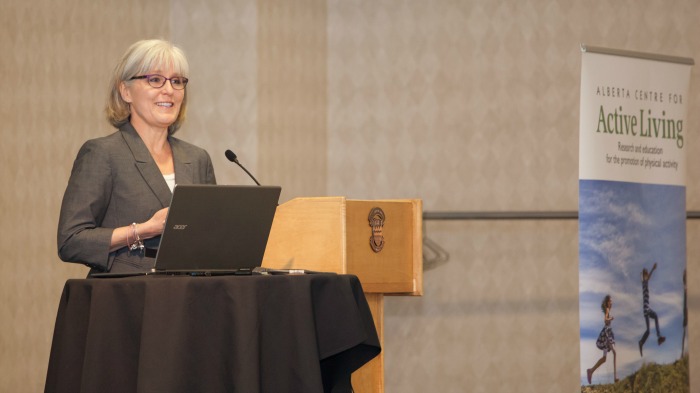
Many new exercisers fail to remain active after the first three months of launching an exercise or workout plan because they face a variety of motivational and other barriers, said Wendy Rodgers at the 2015 Physical Activity Forum hosted by the Alberta Centre for Active Living at the Lister Conference Centre May 1.
Rodgers, a professor and vice-dean in the Faculty of Physical Education and Recreation, suggested that in a world chock full of "fitness slogans, T-shirt messages and boot camps," new exercisers are often surprised how things turn out. "In many cases, the 'real' experience is not quite the same as the slogans would lead us to believe."
"A lot of what passes for motivation these days actually makes us feel bad about our current selves or that we aren't exercising," noted Rodgers. She suggested it's demotivating when people hear statements such as, 'If it were important to you, you'd show up for the workout' or, 'If you don't work for it, you don't deserve it.
"What we need are positive motivational supports and messages," said Rodgers. "This includes supporting people to feel good about themselves and the fact that they are exercising, or at least making attempts."
Roots of motivation: feeling competent and connected
Rodgers leads a team of researchers who study people's motivation to engage in physical activity for the long term, in part, by focusing on self-efficacy theory and self-determination theory. With some of her recent research focused on new exercisers (initiates), Rodgers is able to offer fresh insights.
For example, Rodgers explains that the roots of motivation involve people doing things or having feelings that make them feel good. "Exercisers need to feel they are competent doing the activity; no one likes feeling incompetent. They also need to feel connected to others and that they fit in, plus they need to feel like they have chosen to be there, rather than being forced or told.
"Simply telling people to go do activities they like or find something they love to do is not very effective in most cases," added Rodgers. "In fact, many exercisers do not love exercise or do it for intrinsic reasons. Rather, they do it because they value the activity and outcomes, such as improving their health and feeling good about themselves."
Another factor that helps to motivate people is when being active adds to or fits with a person's sense of identity, said Rodgers.
Moving toward personal satisfaction
Rodgers also suggested that there is no quick fix on the road to personal satisfaction associated with being more active, and that it often takes a year or more for someone to achieve their initial exercise or fitness goals.
"In fact, the path to regular physical activity is fraught with failures and setbacks. For a novice or initiate, starting to exercise is usually complex and often intimidating."
For example, a new exerciser who is just starting out with some kind of exercise plan or goals may attend an initial exercise class, but stay at the back of the class or avoid talking to others.
"To help new participants feel accepted, practitioners need to focus on creating comfortable, supportive environments where people can feel accepted and encouraged," said Rodgers.
Rodgers also says her research reminds us there are a myriad of "life-related" barriers that often prevent a new exerciser from keeping up the motivation to be active year-round.
"This could be a simple cold, flu or period of illness; a holiday leading to weight gain and a drop in motivation; an injury; a family crisis; or any number of things that interfere with a person's momentum or motivation to be active."
Rodgers emphasized that practitioners need to be prepared to accept that such setbacks will happen and be ready to regularly revisit their clients' exercise plans and goals, while staying positive.
Research supports practitioners and public health messages
Nora Johnston, director of the Alberta Centre for Active Living, said that sharing evidence-based research with health and fitness practitioners, policy-makers and the public is an important part of working toward boosting the physical activity levels of Albertans.
"By informing a wide range of health and fitness practitioners, they can, in turn, more effectively support clients and patients in being physically active. Such evidence can also help to shape effective public health policy messaging."
Rodgers also noted that motivation for physical activity is up to each individual, even if practitioners are often readily or necessarily involved. "At the end of the day, each individual needs to take a 'lifestyle approach' to being active. This includes making a conscious choice to be an active person, not inactive. With positive support for their clients, practitioners can help people arrive at a point where they want to exercise, where they value physical activity and feel good about doing it regularly."